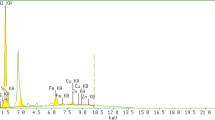Abstract
The surface Young’s modulus (E) and hardness (H) of fused silica samples have been studied by nanoindentation. Two factors strongly affect the results of E and H. One factor is the polishing quality of the fused silica surface. Poor polishing quality produces much smaller E and H than the literature values for bulk fused silica. The second factor is surface flatness. Even for a well-polished silica surface, an “arch bridge effect” may hinder the measurements of the true values of E and H. A correction procedure is proposed to eliminate this effect, and the corrected results show substantial improvements.







Similar content being viewed by others
References
Izumitani TS (1986) Optical glass. Amerian Institute of Physics, New York
Karow HH (1993) Fabricatin methods for precision optics. Wiley, New York
Lambropoulos JC, Xu S, Fang T (1997) Appl Optics 36:1501
Lambropoulos JC, Jacobs SD, Ruckman J (1999) Ceram Trans 102:113
Lambropoulos JC, Fang T, Funkenbusch P, Jacobs S, Cumbo M, Golini D (1996) Appl Optics 35:4448
Lambropoulos JC, Jacobs SD, Ruckman J (1998) In: Proceedings of 18th International Congress on glass. San Francisco, CA, United States, p 3057
Hirao K, Tomozawa M (1987) J Am Ceram Soc 70:497
Oliver WC, Pharr GM (2004) J Mater Res 19:3
Dahmani F, Lambropoulos JC, Schmid AW, Burns SJ, Pratt C (1998) J Mater Sci 33:4677
Product sheet for HPFS® 7980 standard grade, Corning, NY. http://www.corning.com, as on 14 November 2005
Duan K, Steinbrech RW (1998) J Eur Ceram Soc 18:87
Nano Indenter® Operating Instructions, Nano Instruments, Inc., Knoxville, TN (1996), version 2.2
Herrmann K, Jennett NM, Wegener W, Meneve J, Hasche K, Seemann R (2000) Thin Solid Films 377–378:394
Acknowledgments
This work was supported by the U.S. Department of Energy Office of Inertial Confinement Fusion under Cooperative Agreement No. DE-FC03-92SF19460, the University of Rochester, and the New York State Energy Research and Development Authority. The support of DOE does not constitute an endorsement by DOE of the views expressed in this article. One of the authors (L.Z.) gratefully acknowledges C. Pratt for help with nanoindentation tests and the Laboratory for Laser Energetics for a Horton Fellowship.
Author information
Authors and Affiliations
Corresponding author
Rights and permissions
About this article
Cite this article
Zheng, L., Schmid, A.W. & Lambropoulos, J.C. Surface effects on Young’s modulus and hardness of fused silica by nanoindentation study. J Mater Sci 42, 191–198 (2007). https://doi.org/10.1007/s10853-006-1051-2
Received:
Accepted:
Published:
Issue Date:
DOI: https://doi.org/10.1007/s10853-006-1051-2




